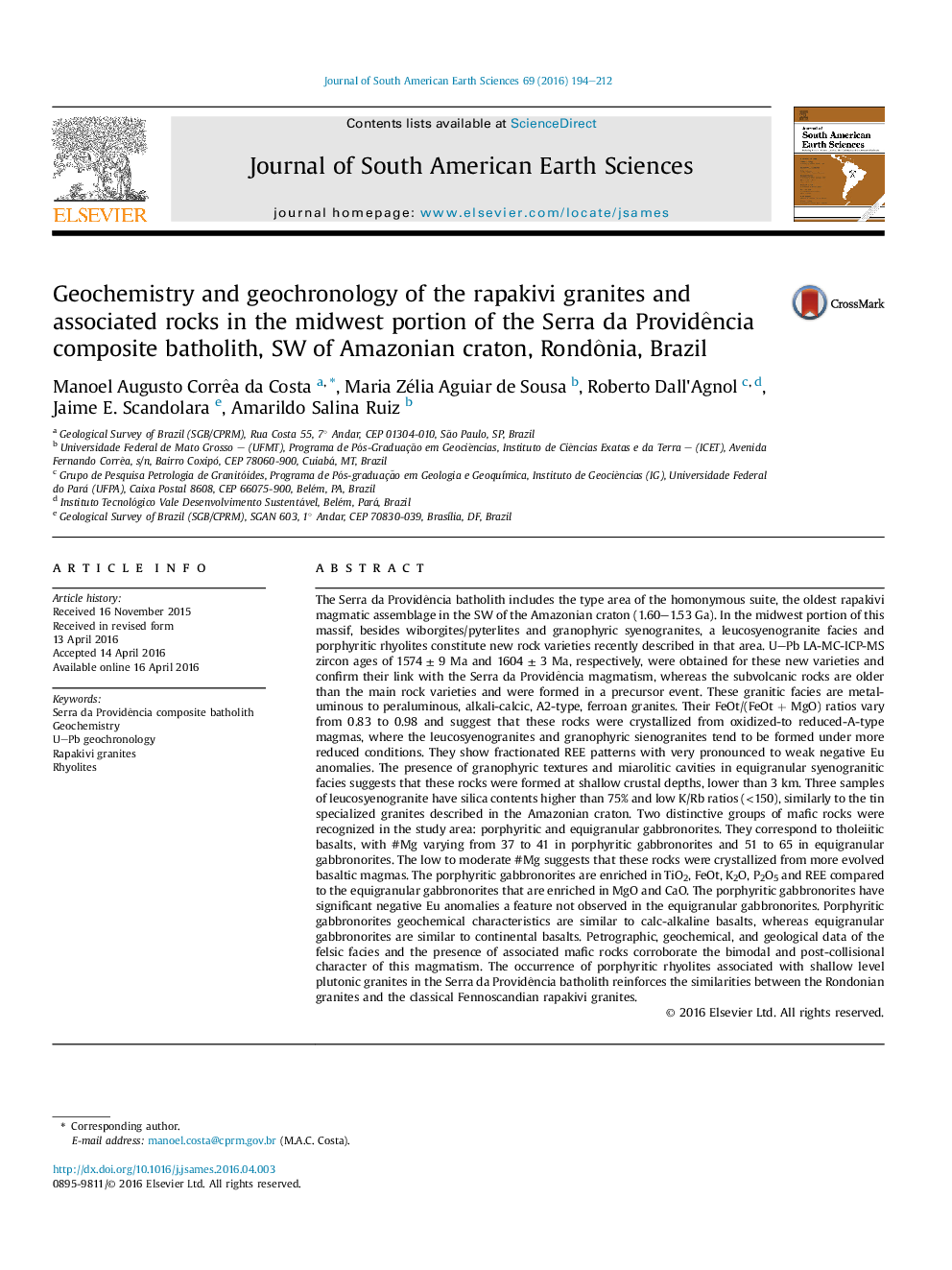| کد مقاله | کد نشریه | سال انتشار | مقاله انگلیسی | نسخه تمام متن |
|---|---|---|---|---|
| 4682077 | 1635141 | 2016 | 19 صفحه PDF | دانلود رایگان |

• Seven facies were mapped in the Serra da Providência batolith.
• Leucosyenogranites and rhyolites are new rock varieties described in the study area.
• Two distinctive groups of mafic rocks were recognized in the study area.
• Porphyritic rhyolites were formed in a precursor event.
• Leucosyenogranites are similar to the tin specialized granites of the region.
The Serra da Providência batholith includes the type area of the homonymous suite, the oldest rapakivi magmatic assemblage in the SW of the Amazonian craton (1.60–1.53 Ga). In the midwest portion of this massif, besides wiborgites/pyterlites and granophyric syenogranites, a leucosyenogranite facies and porphyritic rhyolites constitute new rock varieties recently described in that area. UPb LA-MC-ICP-MS zircon ages of 1574 ± 9 Ma and 1604 ± 3 Ma, respectively, were obtained for these new varieties and confirm their link with the Serra da Providência magmatism, whereas the subvolcanic rocks are older than the main rock varieties and were formed in a precursor event. These granitic facies are metaluminous to peraluminous, alkali-calcic, A2-type, ferroan granites. Their FeOt/(FeOt + MgO) ratios vary from 0.83 to 0.98 and suggest that these rocks were crystallized from oxidized-to reduced-A-type magmas, where the leucosyenogranites and granophyric sienogranites tend to be formed under more reduced conditions. They show fractionated REE patterns with very pronounced to weak negative Eu anomalies. The presence of granophyric textures and miarolitic cavities in equigranular syenogranitic facies suggests that these rocks were formed at shallow crustal depths, lower than 3 km. Three samples of leucosyenogranite have silica contents higher than 75% and low K/Rb ratios (<150), similarly to the tin specialized granites described in the Amazonian craton. Two distinctive groups of mafic rocks were recognized in the study area: porphyritic and equigranular gabbronorites. They correspond to tholeiitic basalts, with #Mg varying from 37 to 41 in porphyritic gabbronorites and 51 to 65 in equigranular gabbronorites. The low to moderate #Mg suggests that these rocks were crystallized from more evolved basaltic magmas. The porphyritic gabbronorites are enriched in TiO2, FeOt, K2O, P2O5 and REE compared to the equigranular gabbronorites that are enriched in MgO and CaO. The porphyritic gabbronorites have significant negative Eu anomalies a feature not observed in the equigranular gabbronorites. Porphyritic gabbronorites geochemical characteristics are similar to calc-alkaline basalts, whereas equigranular gabbronorites are similar to continental basalts. Petrographic, geochemical, and geological data of the felsic facies and the presence of associated mafic rocks corroborate the bimodal and post-collisional character of this magmatism. The occurrence of porphyritic rhyolites associated with shallow level plutonic granites in the Serra da Providência batholith reinforces the similarities between the Rondonian granites and the classical Fennoscandian rapakivi granites.
Figure optionsDownload as PowerPoint slide
Journal: Journal of South American Earth Sciences - Volume 69, August 2016, Pages 194–212